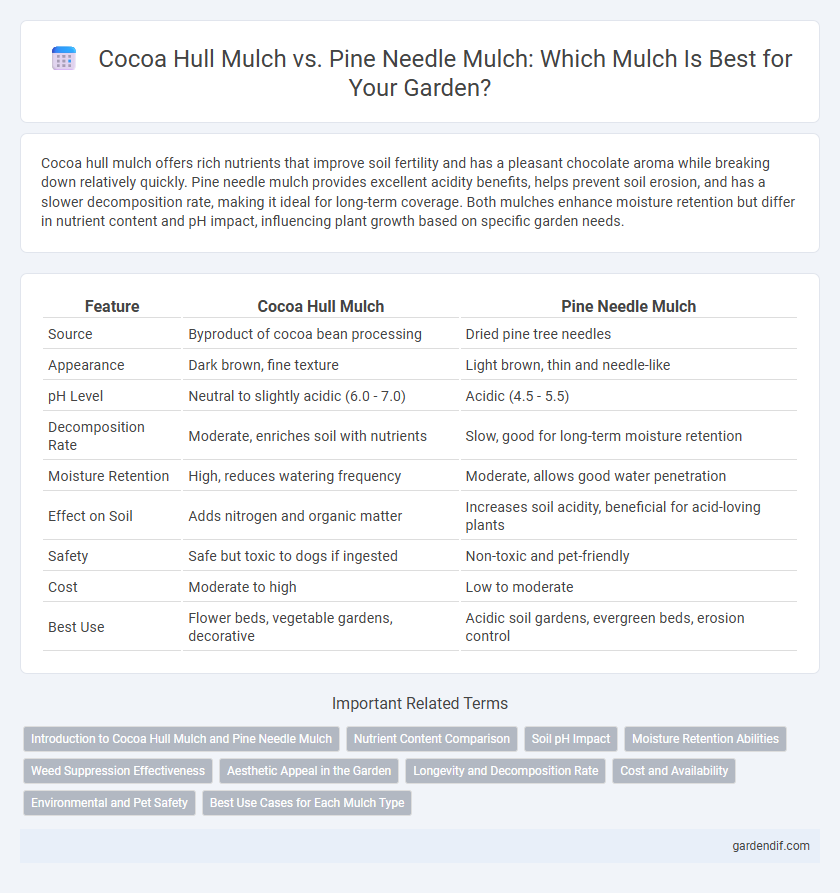
Cocoa hull mulch vs pine needle mulch Illustration
Cocoa hull mulch offers rich nutrients that improve soil fertility and has a pleasant chocolate aroma while breaking down relatively quickly. Pine needle mulch provides excellent acidity benefits, helps prevent soil erosion, and has a slower decomposition rate, making it ideal for long-term coverage. Both mulches enhance moisture retention but differ in nutrient content and pH impact, influencing plant growth based on specific garden needs.
Table of Comparison
| Feature | Cocoa Hull Mulch | Pine Needle Mulch |
|---|---|---|
| Source | Byproduct of cocoa bean processing | Dried pine tree needles |
| Appearance | Dark brown, fine texture | Light brown, thin and needle-like |
| pH Level | Neutral to slightly acidic (6.0 - 7.0) | Acidic (4.5 - 5.5) |
| Decomposition Rate | Moderate, enriches soil with nutrients | Slow, good for long-term moisture retention |
| Moisture Retention | High, reduces watering frequency | Moderate, allows good water penetration |
| Effect on Soil | Adds nitrogen and organic matter | Increases soil acidity, beneficial for acid-loving plants |
| Safety | Safe but toxic to dogs if ingested | Non-toxic and pet-friendly |
| Cost | Moderate to high | Low to moderate |
| Best Use | Flower beds, vegetable gardens, decorative | Acidic soil gardens, evergreen beds, erosion control |
Introduction to Cocoa Hull Mulch and Pine Needle Mulch
Cocoa hull mulch, derived from the shells of cocoa beans, offers rich organic nutrients and a fine texture that improves soil aeration and moisture retention. Pine needle mulch, comprised of long, slender needles, provides excellent acidity regulation and weed suppression while allowing optimal water drainage. Both mulches contribute unique benefits to garden health, with cocoa hull mulch enriching soil fertility and pine needle mulch fostering an acidic environment suitable for acid-loving plants.
Nutrient Content Comparison
Cocoa hull mulch contains higher levels of nitrogen, potassium, and phosphorus, which promote robust plant growth and improve soil fertility. Pine needle mulch is more acidic, contributing to soil pH reduction but offers lower nutrient content compared to cocoa hulls. Both mulches support soil health, but cocoa hull mulch provides a more balanced nutrient profile for garden plants.
Soil pH Impact
Cocoa hull mulch typically maintains a near-neutral to slightly acidic soil pH, ranging from 6.0 to 6.8, which supports nutrient availability and root growth in most garden plants. Pine needle mulch generally increases soil acidity, lowering pH to around 4.5 to 5.5, benefiting acid-loving plants such as azaleas and blueberries but potentially limiting nutrient uptake for others. Choosing between cocoa hull and pine needle mulch depends on target soil pH adjustment and plant species requirements for optimal growth conditions.
Moisture Retention Abilities
Cocoa hull mulch offers superior moisture retention due to its dense and fibrous texture, which slows water evaporation and maintains consistent soil hydration. Pine needle mulch, while providing good aeration and preventing soil compaction, tends to retain less moisture because of its loose, lightweight structure. Gardens with high water requirements benefit more from cocoa hull mulch for sustained moisture conservation.
Weed Suppression Effectiveness
Cocoa hull mulch offers superior weed suppression due to its dense texture and slow decomposition rate, effectively limiting sunlight penetration and inhibiting weed seed germination. Pine needle mulch provides moderate weed control but tends to allow some weed growth because of its lighter, airy structure. Gardeners prioritizing robust weed management often prefer cocoa hull mulch for its long-lasting and consistent barrier against unwanted plants.
Aesthetic Appeal in the Garden
Cocoa hull mulch offers a rich, dark brown color that enhances garden aesthetics with a smooth, uniform texture, complementing both vibrant flowers and greenery. Pine needle mulch provides a natural, rustic look with its reddish-brown hue and lightweight, airy consistency, ideal for woodland-style gardens and acid-loving plants. Both mulches contribute to soil health and moisture retention while distinctly influencing the garden's visual appeal through their color and texture characteristics.
Longevity and Decomposition Rate
Cocoa hull mulch typically lasts longer than pine needle mulch due to its denser composition and slower decomposition rate, which can range from 6 to 12 months depending on environmental conditions. Pine needle mulch decomposes more quickly, often breaking down within 3 to 6 months, releasing nutrients faster but requiring more frequent replenishment. The slower decay of cocoa hull mulch provides prolonged weed suppression and moisture retention, making it a durable option for garden beds.
Cost and Availability
Cocoa hull mulch typically costs more than pine needle mulch due to its specialized processing and packaging, but it offers a rich, dark appearance and pleasant aroma. Pine needle mulch is more widely available and generally less expensive, sourced as a byproduct from pine tree forestry, making it a cost-effective choice for large landscaping projects. Availability of pine needle mulch is higher in regions with abundant pine forests, while cocoa hull mulch is more common in areas near cocoa processing facilities.
Environmental and Pet Safety
Cocoa hull mulch decomposes slowly, enriching soil with natural nutrients but poses a toxicity risk to pets due to theobromine content, which can cause serious health issues if ingested. Pine needle mulch offers a safer alternative for pets, providing natural acidity that benefits acid-loving plants and resists fungal growth while breaking down more gradually without harmful chemicals. Choosing pine needle mulch supports an environmentally friendly garden with lower risks to household animals and sustainable soil enhancement.
Best Use Cases for Each Mulch Type
Cocoa hull mulch excels in flower beds and vegetable gardens due to its rich nutrients and moisture retention, promoting healthy plant growth. Pine needle mulch is ideal for acid-loving plants like azaleas and blueberries because it naturally acidifies the soil while providing excellent aeration. Both mulches improve soil structure but choosing depends on plant type and soil pH requirements.
Cocoa hull mulch vs pine needle mulch Infographic

 gardendif.com
gardendif.com